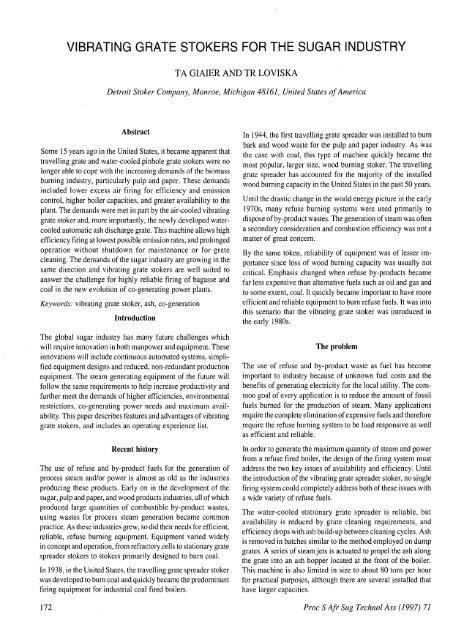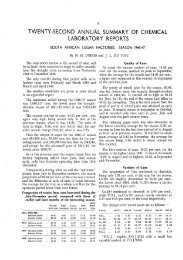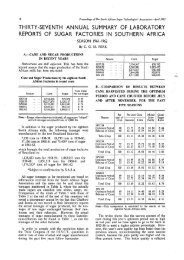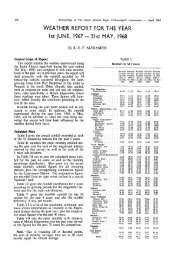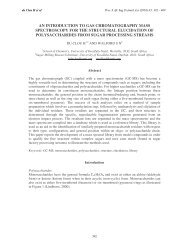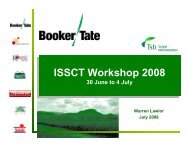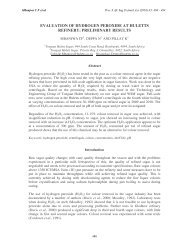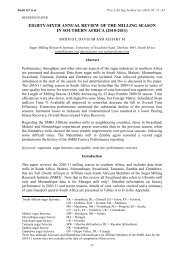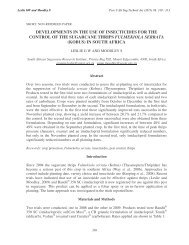VIBRATING GRATE STOKERS FOR THE SUGAR INDUSTRY - sasta
VIBRATING GRATE STOKERS FOR THE SUGAR INDUSTRY - sasta
VIBRATING GRATE STOKERS FOR THE SUGAR INDUSTRY - sasta
Create successful ePaper yourself
Turn your PDF publications into a flip-book with our unique Google optimized e-Paper software.
<strong>VIBRATING</strong> <strong>GRATE</strong> <strong>STOKERS</strong> <strong>FOR</strong> <strong>THE</strong> <strong>SUGAR</strong> <strong>INDUSTRY</strong><br />
TA GIAIER AND TR LOVISKA<br />
Detroit Stoker Company, Monroe, Michigan 48161, United States ofAmerica<br />
Abstract<br />
Some 15yearsago in the UnitedStates,it becameapparent that<br />
travelling grateand water-cooled pinhole grate stokers were no<br />
longerable to cope withthe increasing demands of the biomass<br />
burning industry, particularly pulp and paper. These demands<br />
included lower excess air firing for efficiency and emission<br />
control, higher boiler capacities, and greater availability to the<br />
plant.The demands weremetin part by the air-cooled vibrating<br />
gratestokerand,moreimportantly, the newly developed watercooledautomatic<br />
ashdischarge grate. Thismachine allows high<br />
efficiency firing at lowest possible emission rates, andprolonged<br />
operation without shutdown for maintenance or for grate<br />
cleaning. The demands of the sugarindustry are growingin the<br />
same direction and vibrating grate stokers are well suited to<br />
answer the challenge for highly reliable firing of bagasse and<br />
coal in the new evolution of co-generating power plants.<br />
Keywords: vibrating grate stoker, ash, co-generation<br />
Introduction<br />
The global sugar industry has many future challenges which<br />
willrequire innovation in bothmanpower andequipment. These<br />
innovations willincludecontinuous automated systems, simplified<br />
equipment designs and reduced, non-redundant production<br />
equipment. The steam generating equipment of the future will<br />
follow the same requirements to help increase productivity and<br />
further meetthe demands of higherefficiencies, environmental<br />
restrictions, co-generating power needs and maximum availability.<br />
Thispaperdescribes features andadvantages ofvibrating<br />
grate stokers, and includes an operating experience list.<br />
Recent history<br />
The use of refuse and by-product fuels for the generation of<br />
process steam and/or power is almost as old as the industries<br />
producing these products. Early on in the development of the<br />
sugar, pulpandpaper, andwoodproducts industries, allofwhich<br />
produced large quantities of combustible by-product wastes,<br />
using wastes for process steam generation became common<br />
practice. Astheseindustries grew, sodidtheirneeds forefficient,<br />
reliable, refuse burning equipment. Equipment varied widely<br />
inconceptandoperation, fromrefractory cellsto stationary grate<br />
spreaderstokers to stokers primarily designed to burn coal.<br />
In 1938, in theUnitedStates,the travelling gratespreader stoker<br />
wasdeveloped to burncoalandquickly became thepredominant<br />
firing equipment for industrial coal fired boilers.<br />
172<br />
In 1944, the first travelling grate spreaderwas installed to burn<br />
bark and wood waste for the pulp and paper industry. As was<br />
the case with coal, this type of machine quickly became the<br />
most popular, larger size, wood burning stoker. The travelling<br />
grate spreader has accounted for the majority of the installed<br />
woodburning capacity in the UnitedStatesin thepast 50 years.<br />
Untilthe drasticchangein the worldenergypicturein the early<br />
1970s, many refuse burning systems were used primarily to<br />
dispose ofby-product wastes. Thegeneration of steam wasoften<br />
a secondary consideration and combustion efficiency was not a<br />
matter of great concern.<br />
By the same token, reliability of equipment was of lesser importance<br />
since loss of wood burning capacity was usually not<br />
critical. Emphasis changed when refuse by-products became<br />
far less expensive than alternative fuels such as oil and gas and<br />
to someextent, coal.It quickly became important to have more<br />
efficientand reliable equipment to burnrefusefuels. It wasinto<br />
this scenario that the vibrating grate stoker was introduced in<br />
the early 1980s.<br />
The problem<br />
The use of refuse and by-product waste as fuel has become<br />
important to industry because of unknown fuel costs and the<br />
benefits of generating electricity for the local utility. The common<br />
goal of every application is to reduce the amountof fossil<br />
fuels burned for the production of steam. Many applications<br />
require thecomplete elimination ofexpensive fuels andtherefore<br />
require the refuseburning systemto be load responsive as well<br />
as efficientand reliable.<br />
In orderto generate the maximum quantity of steamand power<br />
from a refuse fired boiler, the design of the firing systemmust<br />
address the two key issues of availability and efficiency. Until<br />
theintroduction of the vibrating gratespreader stoker, no single<br />
firingsystemcouldcompletely address bothoftheseissueswith<br />
a wide variety of refusefuels.<br />
The water-cooled stationary grate spreader is reliable, but<br />
availability is reduced by grate cleaning requirements, and<br />
efficiency dropswithashbuild-up between cleaning cycles. Ash<br />
is removed in batches similarto the method employed on dump<br />
grates. A seriesof steamjets is actuated to propelthe ash along<br />
the grate into an ash hopper located at the front of the boiler.<br />
This machine is also limited in size to about 80 tons per hour<br />
for practical purposes, although there are several installed that<br />
have larger capacities.<br />
Proc S Afr Sug Technol Ass (1997) 71
Vibrating grate stokersfor the sugar industry<br />
The travelling grate remains very efficient although in many<br />
cases maintenance requirements hamper availability. Because<br />
the grate must be air-cooled, the operating procedures necessary<br />
for maximum efficiency are often detrimental to grate life.<br />
Length and width are limited because of the mechanical<br />
limitations of the travelling grate's components.<br />
A solution<br />
The vibrating grate spreader stoker was developed to address<br />
the needs of the refuse burning industry which are perceived to<br />
be the following:<br />
• High availability to maximise operation time of the firing<br />
system.<br />
• Low maintenance requirements to reduce down time and<br />
repair costs.<br />
• High operating efficiency.<br />
• Ability to follow plant load closely.<br />
• Ability to handle large variations in fuel size, quality, ash<br />
content and moisture content.<br />
• Complete compatibility with auxiliary or alternate fuels.<br />
• Complete capability with conventional power boiler designs<br />
which are well proven and cost competitive.<br />
• Compatibility with most existing power boilers for ease of<br />
retro-fitting.<br />
The performance capabilities of the vibrating grate spreader are<br />
quite similar to those of the travelling grate; however, unlike<br />
any existing travelling grate, the vibrating stoker is specially<br />
designed to burn high moisture, low ash refuse fuels and is a<br />
Figure 1. Air-cooled vibrating grate.<br />
it<br />
)1<br />
Proc S Afr Sug Technol Ass (1997) 71<br />
TA Giaierand TR Loviska<br />
derivative of a coal firing design. That is not to say that the<br />
design is entirely new in all respects. It is rather a hybrid machine<br />
which has its roots well established by extensive experience in<br />
the design of water-cooled vibrating grates for deep fuel bed<br />
coal burners and air-cooled vibrating grate spreaders for coal.<br />
Air-cooled vibrating grate<br />
Design<br />
The machine incorporates a horizontal grate surface which<br />
consists of individual air-cooled grate castings attached to a<br />
single moving frame, supported by steel flexing straps. The grate<br />
surface is intermittently vibrated using an eccentric drive at the<br />
rear of the unit. This intermittent vibration provides the necessary<br />
conveying action to the fuel bed and discharges the fuel ash off<br />
the front of the grate in a continuous manner. The mechanism<br />
is similar to that on conventional vibrating chip conveyors used<br />
in many industries (Figure 1).<br />
The features of the air-cooled vibrating grate incorporate the<br />
continuous ash discharge capability with the vibrating grate<br />
simplicity. The design allows for extended periods of operation<br />
without ash protection, minimising grate air flow without<br />
damage.<br />
I STOKER BASELINE<br />
AIR SWEPT<br />
SPOUT<br />
173
Vibrating grate stokers for the sugar industry TA Giaierand TR Loviska<br />
fired refuse burner has been about 225 tIh steam, but no such<br />
limit applies to the vibrating grate stokers.<br />
Since so many of the component systems which make up the<br />
water-cooled and air-cooled vibrating grate stokers have substantial<br />
track records of their own, the machine cannot be<br />
considered revolutionary. The vibrating grate stoker firing<br />
system has evolved as a response to the need for a machine<br />
with its capabilities. Since the vibrating grate stoker was<br />
developed primarily for firing waste fuels, the emphasis to date<br />
has been on the primary users of this type of equipment, namely<br />
the wood products and pulp and paper industries. Other users<br />
of the machine include pulp mills, co-generation plants, coffee<br />
plants and institutional plants fired by biomass.<br />
As indicated earlier, both the water-cooled and air-cooled<br />
vibrating grate technologies evolved from coal firing technology,<br />
and in fact these systems are fully capable of firing coal. In the<br />
United States there are more than 100 air and water-cooled<br />
vibrating grate units firing coal and ranging in size from 25 to<br />
50 tIh steam. Coal can be fired easily using either the existing<br />
fuel feed system, individual coal feeders, or with pulverised<br />
coal burners above the grate.<br />
The design of the grate system is such that it can be retro-fitted<br />
in existing boilers presently fired by travelling grates, pinhole<br />
grates, dumping grates, pulverised coal, suspension fired wood<br />
and, in many cases, oil or gas. Maximum possible heat releases<br />
are attainable, thereby maximising heat input for a given furnace<br />
plan area and often the grate will produce more heat than can<br />
be used or tolerated by the existing boiler. It is therefore likely<br />
that a boiler retro-fitted with the vibrating grate stoker will not<br />
be grate limited. Notable exceptions could be large pulverised<br />
fired units or converted black liquor boilers (Table 1).<br />
Travelling gratespreader<br />
Pinhole grate<br />
Water-cooled vibrating grate<br />
Table 1<br />
Grate heat release rates (MW/m 2 ) .<br />
Operating experience<br />
There are presently 40 water-cooled vibrating grate stokers in<br />
service in pulp and paper mills in the United States, Canada and<br />
South America, with a combined steam capacity of over 4 800<br />
tons/hour. The first unit started up in October 1983, the second<br />
unit has been in operation since November 1984 and the third<br />
since October 1985. The extremely reliable performance led<br />
quickly to the use of this machine in wood fired independent<br />
power producers (IPPs) and sugar mills. To date, 15 IPP plants<br />
and six boilers at sugar mills in the United States and Canada<br />
use the air-cooled or water-cooled vibrating grate (Table 2).<br />
Conclusions<br />
2,05 to 3,15<br />
1,58 to 2,36<br />
2,52 to 4,41<br />
The use of air or water-cooled vibrating grates should be evaluated<br />
when considering a new combustion system or retro-fitting<br />
Table 2<br />
Air and water-cooled vibrating grates burning biomass.<br />
Year Location tJh Year Location tJh<br />
1983 Wisconsin 36 1989 SouthCarolina 127<br />
1984 Ohio 36 Georgia 159<br />
1985 Minnesota 68 Quebec 94<br />
Oregon 2x79 British Columbia 239<br />
Arkansas 295 Chile 120<br />
Alabama 181 Arkansas 163<br />
Maryland 2xll Alabama 68<br />
Ontario 32 British Columbia 159<br />
British Columbia 54 Washington 102<br />
Maine 70 1990 Alabama 68<br />
1986 New Hampshire 63 Newfoundland 71<br />
Maine 63 British Columbia 136<br />
Michigan 63 Washington 91<br />
NewHampshire 64 Louisiana 227<br />
NewHampshire 73 1991 Alberta 210<br />
British Columbia 113 British Columbia 255<br />
1987 Quebec 136 Alabama 91<br />
British Columbia 100 Vermont 86<br />
Maine 45 Brazil 100<br />
Mississippi 61 1993 California 54<br />
1988 Newfoundland 23 1994 Tennessee 36<br />
Alberta 130 Florida 3x200<br />
British Columbia 159 Michigan 156<br />
Brazil 100 Florida 2x200<br />
Alabama 204 1995 Virginia 190<br />
British Columbia 113 NewBrunswick 249<br />
Maine 82 Pennsylvania 68<br />
California 82 Argentina 35<br />
1989 South Carolina 136 1996 Florida 159<br />
an existing unit burning biomass and coal fuels. The sugar industry<br />
has several basic requirements to ensure a competitive<br />
position in the market place, such as high reliability, maximum<br />
efficiency, ease of operation with minimum attendant labour<br />
and low maintenance. These requirements are met with the<br />
following capabilities of the air-cooled and water-cooled vibrating<br />
grate stokers:<br />
• Automatic ash discharge for high load continuous operation<br />
• Load following capability<br />
• Compatibility with other fuels such as coal, oil, gas etc<br />
• Ability to operate continuously<br />
• Compatibility with existing boiler designs<br />
• Ability to fire a wide range of fuel moistures, sizes and ash<br />
content without detriment to efficiency and control<br />
• Lowest possible emissions<br />
• High steam generating capacity.<br />
BIBLIOGRAPHY<br />
Eleniewski, M (1994). Conversion of a black liquor recovery boiler to<br />
wood firing. Case History. CIBO Alternative Fuels IV, February<br />
1994.<br />
McBurney, FB (1994). Large scale biomass plant. NW Energy Corp.<br />
ABMA Technical Conference, May 1994.<br />
Zarraluqui, LR (1995).Curtailing bagasse losses. Proc Am Soc Sug<br />
Cane Technol 24: 75.<br />
Proc S Afr Sug Technol Ass (1997) 71 175


